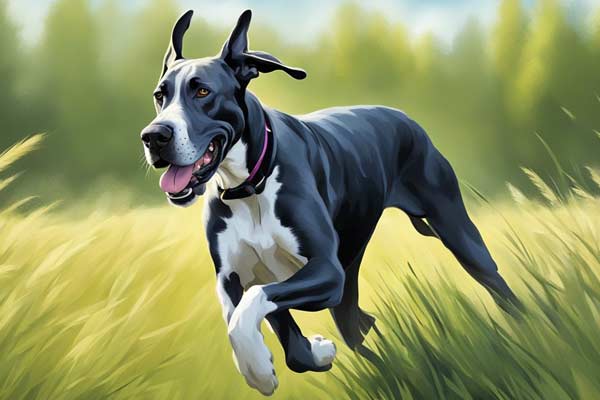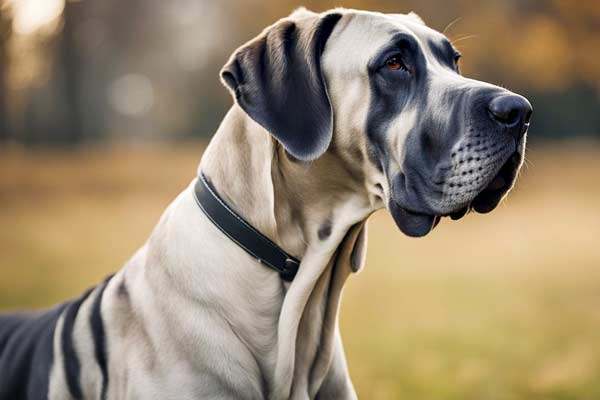Great Danes are known for their majestic size and gentle disposition, making them a popular family choice. However, many pet owners wonder Do Great Danes Need a Lot of Exercise to stay healthy and happy.
The answer is that Great Danes do require a significant amount of exercise, but the exact amount varies depending on their age, health, and individual temperament.
Great Dane puppies are quite lively and require a good amount of physical activity to ensure their health and happiness. However, it’s essential not to over-exercise them, as their growing bones and joints are still developing and can be easily damaged.
As they grow older, their activity levels will naturally decrease, and they’ll need less exercise. However, it’s still crucial to make sure they get an appropriate amount of physical activity to keep them healthy and prevent obesity.

Exercise Needs of Great Danes
Great Danes are renowned for their impressive size and gentle disposition.
They belong to moderately active dog breeds, and to maintain their well-being and happiness, they require daily workouts.
Engaging in physical activity not only helps them manage their weight but also supports their mental health.
For adult Great Danes, a daily exercise regimen of at least 30 minutes to an hour is recommended. However, it’s crucial to understand that each dog is unique and may have distinct exercise needs.
Regular exercise helps keep their muscles toned, joints healthy, and energy levels in check. It can also contribute to better behavior by reducing any pent-up energy.
Walking is a low-impact exercise that is ideal for Great Danes. It provides them with physical activity and mental stimulation while promoting bonding between the dog and the owner. It’s recommended to walk Great Danes for 30-60 minutes per day.
Swimming is another low-impact exercise that is beneficial for Great Danes. It’s a great way to provide them with physical activity and keep them cool during hot weather.
High-impact or over-strenuous exercise can lead to joint pain in Great Danes. Therefore, it’s important to avoid activities that put too much strain on their joints.
It’s also essential to provide them with mental stimulation through playtime, training, or interactive toys.
Impact of Exercise on Great Dane’s Health
Ensuring the good health of Great Danes necessitates consistent physical activity.
This routine exercise aids in maintaining their optimal weight, building stronger bones and muscles, and reducing the risk of various health issues such as hip dysplasia, bloat, arthritis, and obesity.
Since Great Danes are prone to joint and bone issues, exercising them regularly can fortify their bones and joints, reducing the likelihood of these problems.
Exercise also builds and maintains their muscle mass, which is crucial for their overall health.
It’s important to remember not to overdo it when exercising, Great Danes. Too much activity can result in joint problems and obesity. It’s recommended to give them moderate exercise, like daily walks and playtime in a secure yard.
Additionally, Great Danes are at a higher risk of developing bloat, a life-threatening condition where the stomach twists and fills with gas. Exercise can help reduce the risk of bloat, but it is important to avoid intense exercise immediately before or after meals.
Exercise for Different Life Stages
Great Danes require regular exercise to maintain their physical and mental health. However, the amount and type of exercise needed can vary depending on the dog’s life stage. Here are some guidelines for exercising Great Danes at different life stages.
Puppy Great Danes
Puppies are full of energy and crave chances to have fun and discover new things. Yet, they must be shielded from overexertion and harm.
For Great Dane puppies, it’s best to avoid intense workouts or lengthy walks until they reach 18 months, as their bones and joints are still growing.
Instead, provide them with opportunities to play and explore in a secure and supervised setting. Short, regular leash walks can also help improve their socialization skills and obedience training.
Adult Great Danes
To keep adult Great Danes in good health and high spirits, it’s essential to provide consistent exercise. Typically, it’s recommended that adult Great Danes get at least 30 minutes to an hour of moderate exercise.
However, it’s crucial to remember that dogs are distinct and may have varying exercise requirements. One excellent form of low-impact exercise for Great Danes is taking leisurely walks.
It provides them with physical activity and mental stimulation while promoting bonding between the dog and the owner. It’s recommended to walk Great Danes for 30-60 minutes per day.
Other activities such as swimming, jogging, and hiking can also be beneficial for adult Great Danes but should be introduced gradually and with caution.
Senior Great Danes
Senior Great Danes may have reduced mobility and energy levels, but they still need regular exercise to maintain their health and quality of life. However, exercise should be tailored to their individual needs and abilities.
Short, gentle walks on a leash can help keep their muscles toned and joints healthy while providing mental stimulation.
Slow-feeder bowls can also be used to encourage exercise during meal times. It’s crucial to monitor senior Great Danes during exercise and adjust the intensity and duration as needed.
Recommended Exercises for Great Danes
Great Danes, a big and lively breed, need consistent physical activity to maintain their well-being and contentment. Here are some suggested workouts to keep your Great Dane in good shape:
Walking
Walking is a low-impact exercise that is ideal for Great Danes. It provides them with physical activity and mental stimulation while promoting bonding between the dog and the owner.
It’s recommended to walk Great Danes for 30-60 minutes per day. This can be done in the yard, around the neighborhood, or at a local dog park.
Fetch
Playing fetch is another excellent exercise for Great Danes. It provides them with cardiovascular exercise and helps to strengthen their muscles.
It’s essential to use a soft ball or toy that won’t damage their teeth or jaws. This activity can be done in the yard or at a local dog park.
Swimming
Swimming offers a gentle yet effective workout for Great Danes, being kind to their joints. It’s essential to keep an eye on them while they swim, and if they need to be stronger swimmers, consider using a life jacket. You can enjoy this activity in a pool, lake, or ocean.
Dog Sports
Great Danes can participate in dog sports, such as agility, obedience, and rally. These activities provide them with mental and physical stimulation and can be a great way to bond with their owner. It’s important to start training slowly and to use positive reinforcement techniques.
Hunting
Great Danes were originally bred for hunting, and they still have a strong prey drive. Hunting exercises, such as scent work and tracking, can provide them with mental stimulation and satisfy their instincts. It’s important to start training slowly and to use positive reinforcement techniques.
Playing Games
Playing games, such as tug-of-war and hide-and-seek, can be a fun way to exercise Great Danes. These activities provide them with mental and physical stimulation and can be done in the yard or at a local dog park. It’s important to use soft toys and to supervise them during playtime.
Exercise and Behavioral Impact
Great Danes are large dogs that require regular exercise to keep them healthy and happy. Exercise not only helps maintain their physical health but also has a significant impact on their behavior.
Regular exercise can reduce stress, anxiety, and boredom, which can lead to destructive behavior.
Mental stimulation is also a crucial aspect of a Great Dane’s exercise routine. Activities such as fetch or agility training can mentally stimulate these intelligent dogs. It also helps to keep their minds active, which can reduce the risk of depression.
One common issue that Great Danes face is separation anxiety. Regular exercise can help reduce separation anxiety by reducing any pent-up energy they may have. It also helps keep their muscles toned, joints healthy, and weight in check.
It’s important to note that Great Danes can be strong-willed and require a confident owner who can take charge. Regular exercise can help build confidence in these dogs and reduce the risk of behavioral issues.
Socialization and Exercise
Great Danes are social animals and must be well-socialized from an early age. Socialization helps to ensure that they are comfortable and well-behaved in various environments and around other pets and people. Proper socialization can also help to reduce the risk of aggression and anxiety in Great Danes.
Exercise is an essential part of a Great Dane’s daily routine, but it is vital to remember their unique exercise requirements.
Great Danes should refrain from engaging in high-impact exercise or activities that stress their joints, such as jumping or running on hard surfaces.
Also, Great Danes might have some health issues like hip dysplasia and bloat, and these problems can get worse if they don’t get the right exercise.
Regarding socialization and exercise, it is vital to expose Great Danes to various environments and situations. This can include introducing them to other pets and dogs, taking them on walks in public areas, and providing opportunities for them to interact with various people.
Well-socialized Great Danes are generally more comfortable and confident in new environments and around other pets and people.
This can help to reduce anxiety and aggression, making it easier to take them out in public and participate in activities with them.
Living Conditions and Exercise
Great Danes stand out for their impressive size and strength, yet their reputation for gentleness also precedes them.
They prove to be versatile companions capable of thriving in various living environments, though it’s important to note that regular exercise is essential for their overall health and happiness.
When it comes to living conditions, Great Danes can live in apartments as long as they have enough space to move around and get exercise.
However, they are better suited for homes with yards where they can run and play. Great Danes are not recommended for small living spaces, such as studios or tiny apartments, as they need room to move around and stretch their legs.
When it comes to staying fit, Great Danes don’t need a lot of physical activity. They aren’t overly energetic, but they do need daily walks and some playtime.
A regular Great Dane should get about 30-60 minutes of exercise each day, and you can divide this time into multiple short sessions.
Great Danes can take pleasure in swimming as well, and it’s a kind-on-the-joints activity because it’s easy on them. If you have a pool or can get to a safe water spot, swimming is a great way to give your Great Dane some physical activity.
Besides regular exercise, Great Danes also require mental engagement to maintain their happiness and well-being. Puzzle toys, training sessions, and interactive playtime are all effective ways to keep your Great Dane mentally stimulated and avoid getting bored.
Professional Guidance
Regarding the exercise requirements of Great Danes, seeking guidance from professionals such as veterinarians and dog trainers can be helpful.
These experts can provide reputable advice on the appropriate amount and type of exercise for a Great Dane based on age, health, and activity level.
Veterinarians can assess a Great Dane’s overall health and identify any underlying conditions affecting their exercise needs. They can also recommend specific exercises that are safe and beneficial for the breed, considering their large size and potential joint issues.
Dog trainers can guide how to properly exercise a Great Dane and prevent behavior problems from insufficient exercise or boredom. They can also suggest mental stimulation activities that can help keep a Great Dane engaged and prevent destructive behavior.
It’s essential to consult with experienced professionals specializing in Great Danes and comprehend their requirements.

